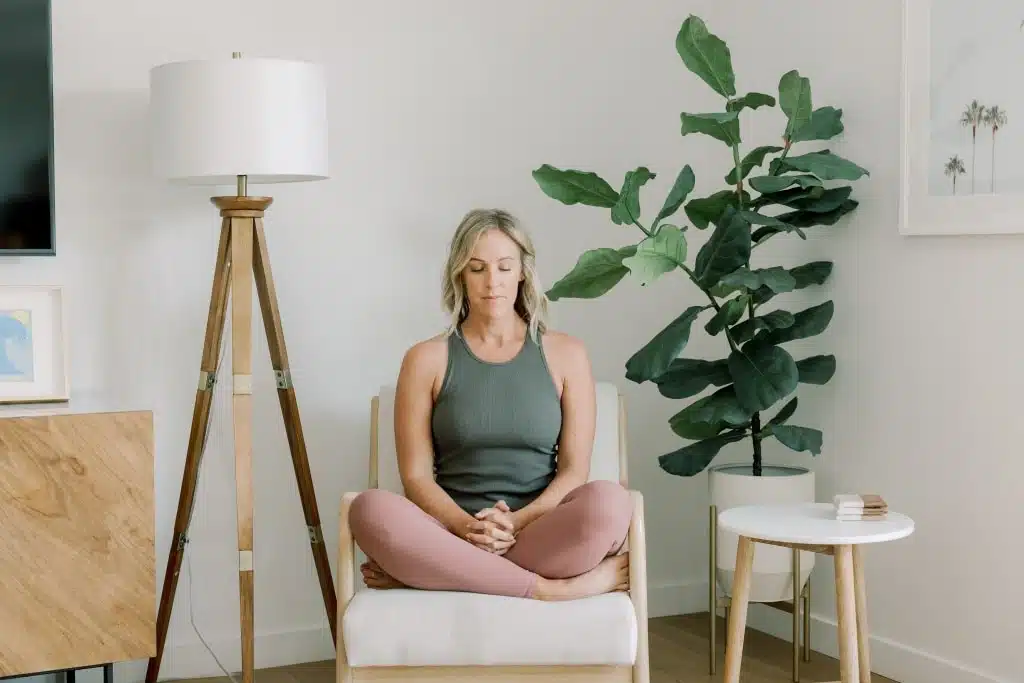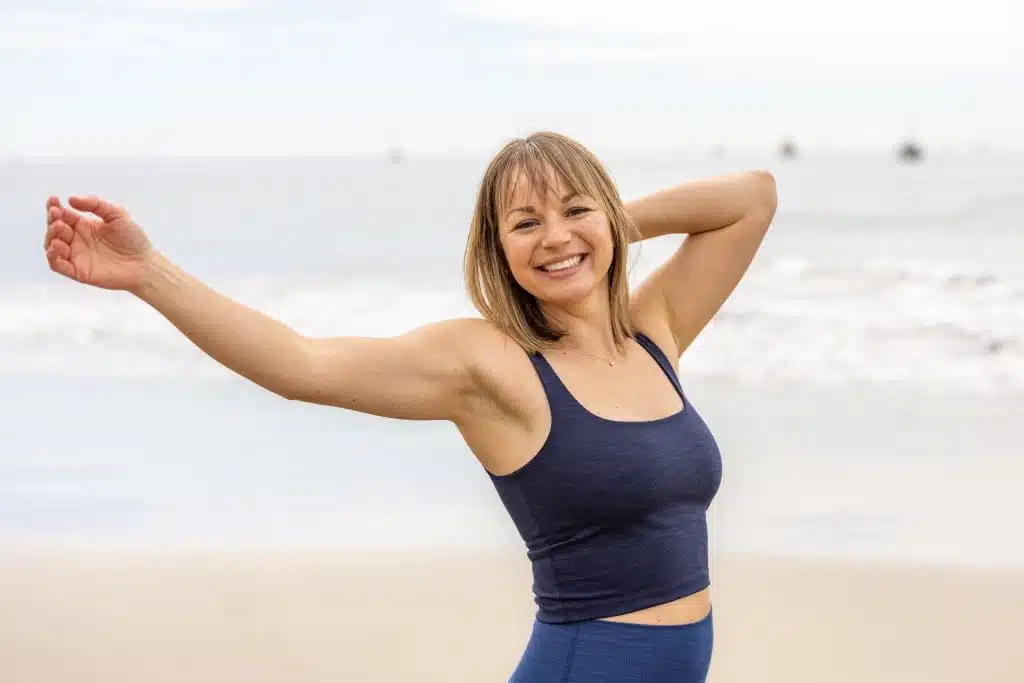
You may have heard someone say, “just listen to your body” and thought: “How do I even do that?” I get it. Learning how to listen to my body has been a practice of mine for the last decade—and I still have to be mindful about it today.
This skill is crucial for maintaining a sustainable health journey in today’s world where we’re often encouraged to ignore our intuition and physical cues. I know you’ve been told, “Push through the pain!” or seen an Instagram post that says, “Don’t stop when you’re tired, stop when you’re done.”
While these sentiments are meant to motivate and inspire, they can also be harmful because they encourage you to ignore your body. The problem is, if you push when your body says stop, you could hurt yourself. If you always force yourself to workout when you don’t want to, you’ll never stay consistent because you don’t enjoy the experience.
Long-term, sustainable health comes when you listen to your body, and then respond with care, action, and compassion. This has been a significant part of my health journey, and a big reason why I started Lindywell, so let’s talk about what it means and how you can start listening.

What Does It Mean to Listen to Your Body?
Listening to the body means cultivating a mindful awareness of what it (you!) needs at any given moment, followed by honoring that need. This intuitive practice will help you understand and make decisions based on internal cues, rather than steamrolling past your own limits.
The more present and responsive you are to these important cues, the more impactful your health journey can be. In fact, simply maintaining intentional body awareness (listening to your body), can improve:
Creating a mindful relationship with your body can also make it easier to instill positive habits around nutrition, exercise, body image, self-care, mental resilience, and coping mechanisms.
- Emotional regulation
- Attentional span
- Self-acceptance
- Brain function
- Compassion
- Stress management
- Anxiety or depression
Plus, when you do what feels good to your body, rather than forcing something that doesn’t, you are often more consistent because you enjoy the experience. This, in turn, leads to better long-term results and feeling more confident.
5 Ways to Listen to Your Body
All that sounds great, but you’re probably wondering how to actually take action. Here are five practical strategies I’ve used to listen to my body and honor those cues each and every day.
1. Ask Questions and Scan Your Body for the Answer
Set aside at least one moment each day to pause and ask yourself, “How do I feel and what do I need right now?” Then before rushing into the next item on your to-do list, take action on what your body needs. Here are some examples:
- I’m feeling tired, so I’m going to have a snack, take a short walk, and then come back to my computer feeling more refreshed and ready for work.
- I’m feeling energized and craving movement, so I’m going to squeeze in a 15-minute Lindywell workout right now, while the kids are at school. That way I don’t have to worry about it when they get home.
- I’m feeling some tension in my neck, so I’m going to do a few neck circles and stretches to ease that discomfort before driving to the store.
In your fast-paced and often hectic life, it’s easy to overlook these basic bodily necessities. The good news is, tuning in and asking what your body needs doesn’t have to derail your day. It may just mean you spend a few minutes stretching or taking a walk—and that will likely make the rest of your day so much better too.
2. Notice How Your Body Reacts to Certain Emotions
Emotions manifest in the body, especially within the cardiac, respiratory, nervous, and gastrointestinal systems. I know I often feel anxiety in my chest or stress in my head. You may be able to recall areas of your body where you commonly feel your emotions too.
Bringing awareness to these emotions, and tuning into where you’re feeling them in the body, can make it easier to soothe those intense reactions and get back to feeling balanced quickly. Next time a strong emotion comes to the surface, be curious about where you feel it.
- Constriction in your throat?
- Warmth in your cheeks?
- Tension in your forehead?
- Sweat in your armpits?
- Nausea in your stomach?
- A pounding heart rate in your chest?
Finally, visualize sending love, calm or peace to that area of the body while taking slow, deep breaths until you start to regain equilibrium. You may be surprised by how quickly the emotion passes compared to the times when you try to push it aside.
In fact, according to Dr. Jill Bolte Taylor, all it takes is 90 seconds to move through an emotion if you stop, identify it, and simply maintain awareness of that emotion. Instead of letting that pesky anxiety hang around all day, let it go right then and there!
3. Build a Mindfulness Practice Around Meal Times
Bring mindfulness to meal times to start creating greater body awareness. The idea is simple: when you’re eating a meal, slow down and tune into your senses.
- What do you smell?
- How does it taste?
- What is the texture like?
- Do you hear crunching or slurping sounds?
By practicing this for even just one meal a day—eating dinner with kids is likely not the easiest time to practice this, but perhaps a solo lunch is—you’re training yourself to slow down and listen to your body. This may also make it easier to notice hunger cues that say you’re full or you want to go in for seconds; a skill that most of us have lost touch with.
In addition, mindful eating can reduce stress, promote digestive health, increase body acceptance, and curb emotional eating behaviors.
4. Choose Your Workout Based on What Your Body Needs
Your workouts are most effective when they match your current energy levels, stamina, and time capacity—all of which fluctuates from one day to the next. One morning I might wake up with the motivation to do a 30-minute weighted Pilates workout, while the next day, I desire a slow, 15-minute stretching session in the afternoon.
This is so normal for women and why cycle syncing your workouts can be really beneficial. If you don’t have a cycle, however, you can still choose workouts each day based on what your body is asking for.
Pause before starting a workout and tune into which kind of movement feels most enjoyable at the moment. Do your legs feel strong and ready for a challenge? Or does a slower-paced movement sound really good? Plus, ask yourself: do I have extra time or do I need to fit something in quickly? Choose your workout based on these answers.
It’s really easy for Lindywell members to honor what their body is craving (and their schedule calls for) because we have 300+ workouts, both gentle and challenging, that range from 10 minutes to 30+ minutes. As a member, you’ll find whatever workout you need, no matter the season or time frame.
Start your 14-day free trial to get instant access to all of our workouts, plus guided breathwork sessions and nourishing recipes!
5. Carve Out Alone Time to Connect with Your Body
When was the last time you thought of your body as a friend to connect with, instead of just a vehicle to move through life? All too often, the focus is on pushing through and getting things done so you forget to spend time with yourself and your body. I fall into that rhythm so easily as a busy mom and business owner and have to be really intentional about this.
Whether you can spare 2 minutes or 20, carve out time and space each week—if possible, each day—to be alone with yourself. Unplug from social media and other external distractions and just connect. You can do this by listening to gentle music, moving your body, meditating or even doing a breathwork session in the Lindywell app.
Practicing mindfulness like this, especially using meditation to do so, can improve your memory, mood and overall well being. Plus it helps you start to understand the language of your body so it’s easy to hear what it’s asking for.
Listening to Your Body Is a Integral Part of Wellness
Your body is always speaking to you—but are you listening? No matter how long it’s been since you last paid attention to those inner cues (or you never have before), consider this an invitation to start. These practical strategies will help you listen to your body, and as a result, get more consistent with workouts, choose movement you enjoy, and ultimately, see better results. It truly is the key to long-term health and happiness.
Take your relationship with your body one step further with my upcoming book, Well to the Core! In it, I dedicate an entire chapter to developing the skill of listening to our bodies and how we can break free from the confines of problematic fitness sayings and develop a more holistic and sustainable approach to our fitness journeys. Pre-order your copy now and get $300 in free bonuses!






